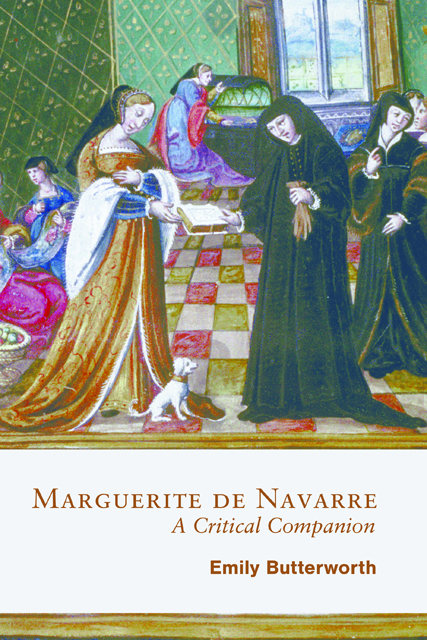Book contents
- Frontmatter
- Dedication
- Contents
- List of Illustrations
- Acknowledgements
- Note on Names and Editions
- Editions of Reference
- Introduction: A Brief Literary and Historical Chronology
- 1 Communities
- 2 Religion
- 3 Politics
- 4 Women and Men
- 5 Desire
- 6 Form and Technique
- Conclusion: Print and Public
- Bibliography
- Index
2 - Religion
Published online by Cambridge University Press: 20 December 2023
- Frontmatter
- Dedication
- Contents
- List of Illustrations
- Acknowledgements
- Note on Names and Editions
- Editions of Reference
- Introduction: A Brief Literary and Historical Chronology
- 1 Communities
- 2 Religion
- 3 Politics
- 4 Women and Men
- 5 Desire
- 6 Form and Technique
- Conclusion: Print and Public
- Bibliography
- Index
Summary
All of Marguerite de Navarre’s work is inspired and deeply marked by her religious beliefs. From the chansons spirituelles to her theatre and her masterpiece, the Heptameron, she wrestles with the challenges of living a spiritual life in a fallen world. She lived at a time when it was not straightforward to be a Western European Christian. The sixteenth century was a turbulent and traumatic period of religious history. The Protestant Reformation split the Western Christian church into two, and as the sixteenth century progressed the ideological conflict turned, inevitably it seemed, into violence and civil war across Europe as the coexistence of different religious beliefs seemed increasingly fraught. In France, the promise of new learning and new discoveries embodied in the humanist movement at the beginning of the century was shattered in a series of intractable and destructive civil wars known as the Wars of Religion (1562–98), stoked not just by religious division and hostility but also by rivalry between powerful French noble families. Marguerite did not live to see France’s descent into civil chaos, but she did witness a hardening of sectarian positions and an intolerance of different beliefs on all sides that led to persecutions for heresy and state-sanctioned massacre.
This chapter will explore the religious conflicts that provide a backdrop and often the material for Marguerite’s work. In the first two sections, I look at the context in which Marguerite was writing: the first section is a brief introduction to the Reformation, the issues that divided Catholics and Protestants, and the position of the French Evangelicals; then I turn to the situation in France, the persecution of reformers, and the French Evangelicals’ response. The next sections take Christian themes that marked the Reformation debates and that recur in Marguerite’s work to explore in more detail: sin; false pride; faith and grace; and mysticism and death. I read Marguerite’s religious poetry – Le Miroir de l’âme pécheresse, Les Prisons, and Les Chansons spirituelles – alongside the Heptameron, which continues her meditation on these matters in a secular setting.
Catholics, Protestants, Evangelicals
There have been many movements of reform in the history of Christianity, but the period we now call the Reformation was a particularly spectacular one.
- Type
- Chapter
- Information
- Marguerite de NavarreA Critical Companion, pp. 41 - 74Publisher: Boydell & BrewerPrint publication year: 2022

